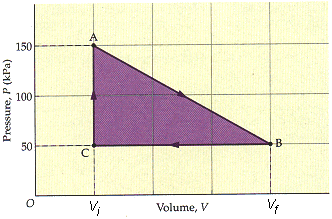PHYS 1702 Lecture 3: Physics Lecture Notes 3

Pressure (in a liquid or gas) is = Force/Area
Work= Pressure x Volume where the derivative of work is pressure (volume2-volume1)
The change in internal energy(= Q-W) is the chemical potential energy stored in foods
-the body can do work if the internal energy is not to drop, there must be energy coming in
-if it is not in the form of heat, the body loses heat rather than absorbing it
Heat Energy Transfer: there are three ways:
-conduction
-convection
-radiation
*Change in Q= k*A*change in temperature/L where k=thermal conductivity which is how fast or
slow materials are to conduct heat energy, A= area, and L=length
- the change in Q is directly proportional to A*change in temperature/L
There are three cases that we need to keep in mind:
1) Case 1: If W or work=0, then the change in intern energy is equal to the Q or heat energy
because in this case, you are in a constant volume
2) Case 2: If Q=0, then you have an adiabatic process
3) Case 3: For a free expansion, the change in internal energy is equal to 0
Chapter 19: Kinetic Theory of Gases
-a gas consists of atoms alone bonded together as molecules
Total Internal Energy:
-is divided into two types of energy: kinetic and potential energy where kinetic energy can be
subdivided into three types of energy: 1) random translational energy, 2) vibrational energy,
3) rational energy
*The volume of a gas increases and is directly proportional to its mass
-as proven that pV, pressure and volume, is directly proportional to mT, mass and temperature
According to Boyle’s Law, for the motions of the atoms to its volume, pressure, and
temperature, at a constant temperature V, volume, is directly proportional to 1/P (1/pressure)
-the ideal gas law states that VP= constant
According to the mole formula, n(mole) is equal to mass or N (grams)/the molecular mass or Na
(g/mole)
-deriving pV=nRT, n(mole) can be substituted for N/Na so that you have pV=(N/Na)RT
-However, R/Na is the Boltzmann’s constant where R/Na is equal to k
-Therefore, our new formula is pV=NkT







